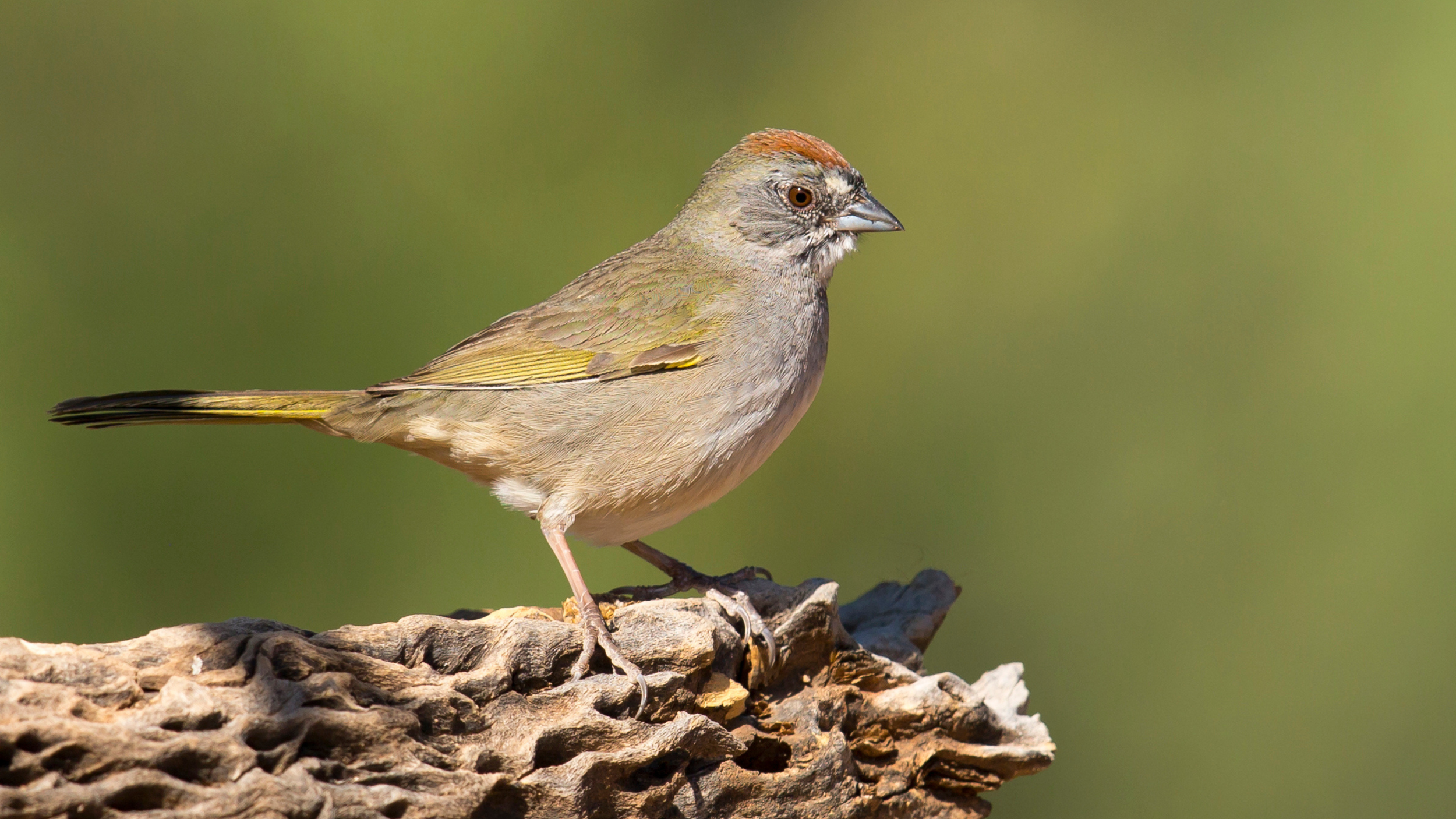Bird of the Month: Green-tailed Towhee
Written by Andy McCormick
Andy McCormick, Volunteer and Former Board President of Eastside Audubon
The Green-tailed Towhee, common in much of the Great Basin area, is a local breeder in the shrubby slopes of the Blue Mountains of southeastern Washington.
Looking more like a large sparrow with a short tail and smallish bill, the Green-tailed Towhee has an overall olive appearance with golden green highlights in the wings and tail (Aversa, et al). Its jaunty rufous cap and white throat are set off nicely against the gray head and chest, where the gray gradually fades to a white belly. The sexes are similar in appearance. The juvenile is quite different with heavy streaking overall and olive-tinged upperparts (Alderfer). Photos, videos, and vocalizations of the Green-tailed Towhee can the found at The Macaulay Library.
The Green-tailed Towhee is a close relative of the Spotted and Eastern Towhees and joins them in the genus Pipilo, from the Latin pipo, meaning chirp, peep, or twitter. The specific epithet chlorurus, is from the Greek khloros, greenish yellow, or pale green, and oura, tail (Holloway).
PREFERS SHRUBBY SLOPES
The Green-tailed Towhee is a bird of chapparal and sagebrush and other low thickets in semi-open country usually on mountain slopes. Like other towhees, it uses both feet to forage under shrubs and in leaf litter. It makes a hopping motion forward and scratches backward as it looks for a variety of insects including beetles and crickets. It also eats seeds of weeds and grasses. In general, this towhee stays hidden and can be located by its cat-like mewing call. However, in spring it will find a prominent perch and sing to mark its territory.
The Green-tailed Towhee is not well-studied, and we know few details about its incubation and fledging timeline. However, we do know that it builds a cup nest of grasses, twigs, and weeds on the ground or low in shrubs, and it is thought that both parents feed the nestlings (Kaufman). Lack of research data also prevents estimates for its population. There are no habitat management programs dedicated to this species. However, preservation of sagebrush and shrub-steppe habitat will likely help the Green-tailed Towhee maintain its population (Dobbs et al).
Green-tailed towhee
Scientific Name: Pipilo chlorurus
Length: 7.25”
Wingspan: 9.75”
Weight: 1 oz (29 g)
AOU Alpha Code: GTTO
DISTRIBUTION AND MIGRATION
The breeding range of the Green-tailed Towhee is usually between altitudes of 3,000 and 12,000 feet (Wright). The range follows shrubland habitat from the southeastern corner of Washington and southern Idaho and Montana through the Cascades and Rocky Mountains to the Sierra Nevada in eastern California. Its range continues south through Nevada, Utah, western Colorado into northern Arizona and New Mexico. Most Green-tailed Towhees are fully migratory and winter from the latter two states south to west and central Mexico.
Early records of the Green-tailed Towhee in Washington were speculative. Dawson (1909) noted only four records. Jewett, et al (1958) cited the same four records and said only one had merit. Wahl, et al (2005) reported breeding locations in the Blue Mountains. Multiple observations posted on eBird have documented breeding Green-tailed Towhees in many locations in Walla Walla County, most recently on Biscuit Ridge Road and Lewis Peak.
A NOTE ON TOWHEE TAXONOMY
All six North American towhees were formerly placed in the genus Pipilo and older field guides will reflect this. However, genetic research published in 2009 implied that members of the “brown towhee complex” comprised of California Towhee (M. crissalis), Abert’s Towhee (M. aberti), and Canyon Towhee (M. fuscus), are more closely related to the ground sparrows of Mexico and Central America than they are to the black or green towhees. Therefore, these three brown towhees were moved to the genus Melozone in 2010, joining five more southern members of the genus: In Mexico: Rusty-crowned Ground-Sparrow (M. kieneri) and White-throated Towhee (M. albicollis); in Central America: White-eared Ground-Sparrow (M. leucotis), White-faced Ground-Sparrow (M. biarcuata), and Cabanis’s Ground-Sparrow (M. cabanisi) (Birds of the World, Cornell Lab of Ornithology).
Photo credit: Mick Thompson
References available upon request from amccormick@eastsideaudubon.org
Visit the Eastside Audubon Bird Gallery to read Bird of the Month articles covering over 200 bird species.



